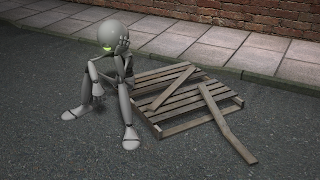Transferring lighting from Maya Software to Mental Ray
Motion Blur
By changing shutter settings, sampling and blur-frame ranges, different effects can be achieved.
The motion blur on the wheel differs using different Shutter open/close settings, Time samples and motion steps.
The wheel can also be motioned blur using the no deformation setting, which although quicker to render, can have less quality.
When rendering motion blur, the Rasterizer rendering method can be used rather than Scanline, as shown below. In the second image, the shading quality has been increased.
Depth of Field
Using basic Depth of Field on a May camera in mental ray can produce some good results once the Sample and anti-aliasing settings are adjusted.
A mental ray lens can be added to the camera called 'Bokeh', this produces a better quality Depth of Field and once the distance is measured and the 'Plane' attribute changed, some impressive and simple results can be achieved.
Final Gather
This tutorial helped the final gather settings seem much easier to understand. Below shows the way it can be diagnosed and be optimised changing the settings. It is also important to Optimise the map for animation to avoid shadow issues.
Global Illumination
Using Photons in an area light and a Mental ray 'Temperature' node on a directional light allows global illumination to be used effectively. It can be diagnosed similar to Final Gathering, as shown below.
Caustics
Caustics can create more realistic glow effects through materials as well as colour bleed where light bounces and reflects surfaces. By increasing the caustic colour a glow effect can be achieved like below.
Mia_material_x
This tutorial showed the range of material presets in Mental Ray's Material_X shader.
Physical Sun and Sky
Below are some shots from the Physical lighting tutorial. It shows the effects of changing a few settings such as Saturation, Red/Blue shift or Horizons.
Shadow softness settings on the Physical Sun node:
I'll post up the remaining tutorials tommorow, I'm in the middle of rural Cornwall for the next few days but hopefully I can find Internet somewhere to upload some more images.





























0 Responses to 'Mental Ray Tutorials'
Post a Comment